AI act timeline explained
The AI Act is the EU’s landmark law on artificial intelligence. Rather than flipping a switch overnight, the EU is rolling it out step by step, giving governments and companies time to prepare while making sure key protections come into force quickly. Below you can find a broad overview of the AI act timeline.
2024-2025: Publishing the AI act
The law was officially published on 12 July 2024 and entered into force on 1 August 2024. That date marks the starting line, but no obligations applied yet.
The first real changes arrive on 2 February 2025, when bans on certain harmful AI practices kick in, along with basic rules on AI literacy. Just a few months later, on 2 August 2025, the Act gets teeth: governance structures, enforcement powers, penalties, and rules for general-purpose AI all begin to apply.
Member States must also have their regulators in place by then. Providers of AI models already on the market get a grace period until 2027 to comply fully.
2026: Attention to high-risk AI
By 2026, attention shifts to high-risk AI. The Commission will publish guidance in February, and by August, most of the Act’s obligations for these systems come into effect.
This includes requirements for operators of high-risk systems that undergo significant design changes from that date onwards. Member States are also required to have at least one operational AI regulatory sandbox by this point. This is offering a controlled environment for companies to test and refine AI systems under regulatory supervision.
2027: Governing classification applies
The timeline reaches a critical stage in 2027. On 2 August of that year, the central provision governing the classification of high-risk AI fully applies. By the same date, providers of GPAI models that were already in use before August 2025 must also be fully compliant.
For large-scale IT systems used by EU public bodies, the compliance deadline is set later, with a final cut-off of 31 December 2030. This gives more time for the complex infrastructures underpinning public services to align with the regulation.
Beyond 2027: Review and adjustments
Beyond 2027, the AI Act enters a phase of review and adjustment. From 2028 onwards, the Commission will begin systematic evaluations. This involves assessing the functioning of the newly established AI Office, reviewing codes of conduct and transparency measures, and reporting on energy efficiency standards for general-purpose AI.
By 2030, all public sector deployers of high-risk systems must comply, and by 2031 the Commission will deliver a comprehensive assessment of enforcement to the European Parliament, the Council, and the European Economic and Social Committee.
When was the AI Act introduced?
The European Union recognized the need for clear rules as artificial intelligence became more powerful and widespread. Policymakers wanted to balance innovation with safety.
So, the AI Act timeline began long before the law was officially introduced. Understanding this timeline helps us see how much thought and effort went into shaping the world’s first comprehensive AI regulation.
The early discussions and groundwork
Long before the AI Act appeared in headlines, conversations about regulating artificial intelligence were already happening. Experts, lawmakers, and industry leaders gathered to discuss the risks and opportunities AI presented.
These early talks focused on privacy, AI ethics, and the potential for bias in algorithms. The European Commission started collecting feedback from citizens, businesses, and researchers.
This phase of the AI Act timeline was all about listening and learning. It set the stage for the next steps by highlighting what mattered most to people across Europe.
The official proposal and public reaction
The big moment came on April 21, 2021. That’s when the European Commission formally introduced the AI Act proposal. This was a major milestone in the AI Act timeline.
The announcement sparked immediate reactions from tech companies, advocacy groups, and governments around the world. Some praised the EU for taking bold action, while others worried about stifling innovation.
Public consultations followed, allowing everyone to weigh in on the proposed rules. The debate was lively and sometimes heated, but it helped refine the law’s details.
From proposal to adoption: final steps
After the proposal, the AI Act entered a period of negotiation and revision. Lawmakers debated everything from definitions to enforcement.
Committees reviewed the text, and amendments were made to address concerns raised during the public consultation. This part of the AI Act timeline was marked by compromise and collaboration.
Finally, after months of work, the European Parliament and Council reached an agreement. The AI Act was officially adopted, setting a new global benchmark for responsible AI governance.
How will the AI Act timeline impact implementation?
The AI Act timeline is more than just a set of dates on a calendar. It’s a roadmap that will shape how organizations prepare, adapt, and ultimately comply with new regulations.
Each phase of the timeline brings its own challenges and opportunities, forcing businesses to rethink their strategies and workflows. The impact will be felt across teams, from legal to technical, as everyone works to keep pace with evolving requirements.
Understanding the phases of the ai act timeline
The AI Act timeline is broken into clear stages, each with its own deadlines and expectations. Early phases focus on awareness and preparation, giving organizations time to assess their current systems and identify gaps.
As the timeline progresses, the focus shifts to implementation and compliance, with stricter rules coming into play. This phased approach means companies can’t afford to wait until the last minute. Instead, they need to build a plan that evolves alongside the timeline, ensuring they’re ready for each new requirement as it arrives.
Challenges for organizations during implementation
With every new checkpoint on the AI Act timeline, organizations face fresh hurdles. Some will struggle with interpreting what the law actually requires, especially when it comes to high-risk AI systems. Others may find themselves racing against the clock to update documentation, retrain staff, or overhaul technical infrastructure.
The pressure to comply can lead to rushed decisions, which sometimes create more problems than they solve. But the timeline also offers a chance to pause and reflect, allowing teams to learn from early mistakes and adjust their approach.
Opportunities for innovation and collaboration
While the AI Act timeline introduces plenty of stress, it also opens doors for creative thinking. Teams that start early can use the extra time to experiment with new tools, refine their processes, and even collaborate with partners or regulators.
This period of transition is a opportunity to break down silos and encourage cross-functional teamwork. By treating the timeline as a series of milestones rather than obstacles, organizations can turn compliance into a competitive advantage.





